The American Psychiatric Association (APA) recently moved into its new flagship office at The Wharf, 800 Main Avenue SW in Washington, D.C. The OTJ Architects-designed space will occupy 63,000 sf across the building’s 9th, 10th, and 11th floors.
Two of the more unique elements of the space are a two-story glass staircase that connects the 10th and 11th floors and a large lounge that is contiguous to the main conference room that can accommodate all 200 staff. Additionally, a glass-walled boardroom uses a state-of-the-art audio/visual system and two conjoined “eyebrow-shaped” tables that can seat up to 30 people with unobstructed sightlines.
 Courtesy of OTJ Architects.
Courtesy of OTJ Architects.
The office was designed to be modern, open, and collaborative. “We have included many collaborative spaces, as well as individual offices and expansive meeting areas,” says OTJ Associate Preeti Reddy, NCIDQ, IIDA, in a release. “The floorplan has also been designed to ensure everyone is able to enjoy the inspiring vistas of the Capitol Building, Jefferson Memorial and, of course, the Potomac River.”
OTJ designed the office to meet LEED Gold Certification standards and also incorporated WELL Building Standard strategies. The APA moved into the new space in December 2017.
Related Stories
| Oct 6, 2010
Windows Keep Green Goals in View
The DOE's National Renewable Energy Laboratory has almost 600 window openings, and yet it's targeting LEED Platinum, net-zero energy use, and 50% improvement over ASHRAE 90.1. How the window ‘problem’ is part of the solution.
| Sep 21, 2010
New BOMA-Kingsley Report Shows Compression in Utilities and Total Operating Expenses
A new report from the Building Owners and Managers Association (BOMA) International and Kingsley Associates shows that property professionals are trimming building operating expenses to stay competitive in today’s challenging marketplace. The report, which analyzes data from BOMA International’s 2010 Experience Exchange Report® (EER), revealed a $0.09 (1.1 percent) decrease in total operating expenses for U.S. private-sector buildings during 2009.
| Sep 13, 2010
Triple-LEED for Engineering Firm's HQ
With more than 250 LEED projects in the works, Enermodal Engineering is Canada's most prolific green building consulting firm. In 2007, with the firm outgrowing its home office in Kitchener, Ont., the decision was made go all out with a new green building. The goal: triple Platinum for New Construction, Commercial Interiors, and Existing Buildings: O&M.
| Aug 11, 2010
CTBUH changes height criteria; Burj Dubai height increases, others decrease
The Council on Tall Buildings and Urban Habitat (CTBUH)—the international body that arbitrates on tall building height and determines the title of “The World’s Tallest Building”—has announced a change to its height criteria, as a reflection of recent developments with several super-tall buildings.
| Aug 11, 2010
BIG's 'folded façade' design takes first-prize in competition for China energy company headquarters
Copenhagen-based architect BIG, in collaboration with ARUP and Transsolar, was awarded first-prize in an international competition to design Shenzhen International Energy Mansion, the regional headquarters for the Shenzhen Energy Company.
| Aug 11, 2010
Jacobs, Arup, AECOM top BD+C's ranking of the nation's 75 largest international design firms
A ranking of the Top 75 International Design Firms based on Building Design+Construction's 2009 Giants 300 survey. For more Giants 300 rankings, visit http://www.BDCnetwork.com/Giants
| Aug 11, 2010
New air-conditioning design standard allows for increased air speed to cool building interiors
Building occupants, who may soon feel cooler from increased air movement, can thank a committee of building science specialists. The committee in charge of ANSI/ASHRAE Standard 55 - Thermal Environmental Conditions for Human Occupancy—after months of study and discussion--has voted recently to allow increased air speed as an option for cooling building interiors. In lay terms, increased air speed is the equivalent of turning up the fan.









